⇦ Back to Soil Fertility and Plant Nutrition Home
¶ Introduction
Testing for “available” soil phosphorus is a key nutrient management strategy. Differences between methods can be confusing. This Crop File discusses differences between the three primary phosphorus analysis methods. This Crop File illustrates these differences using research from Iowa State University and the University of Idaho with a wide range of soil characteristics. These research results agree well with our own in-house research and extensive observations.
ServiTech Laboratories adopted the Mehlich-2 extraction in 1978 as the default phosphorus method, then switched to the Mehlich-3 extraction as default in 1993. The Mehlich-3 method works across a very wide range of soil characteristics. Few, if any, laboratories have as much experience with the Mehlich method as ServiTech Laboratories.
¶ A. Soil Phosphorus Analysis
- Total phosphorus measurement not agronomically useful.
- Soil analysis method must relate to fraction of total phosphorus available for plant uptake
- Soil is mixed with extracting solution for short time, 5 minutes to 30 min. depending on method)
- Soil-solution mixture is filtered to remove soil
- Remaining solution is analyzed for phosphorus content, then is related to soil “availability”
- Soil pH is primary driver of phosphorus availability
- Acidic soils: fixation dominated by iron (Fe) and aluminum (Al) phosphates
- Alkaline soils: fixation dominated by calcium (Ca) and magnesium (Mg) phosphates
- Calcareous soils: fixation dominated by adsorption onto surfaces of finely divided carbonate particles (i.e., “excess lime”)
¶ B. Soil test phosphorus method differences
- Are three primary soil phosphorus tests used in U.S. crop nutrient management
- Bray-1 method
- Used mainly in Midwestern states
- Developed in 1945 at Ohio State University
- Adapted primarily to neutral and acidic soils
- Should not be used on soils having carbonate content greater than 2% to 3%; i.e., soils with high “excess lime”
- Uses hydrochloric acid and ammonium fluoride solution with pH of 2.6
- Extracts soluble-P by releasing Fe-bound and Albound phosphorus
- Excess carbonates can neutralize single hydrochloric acid extractant component, resulting in low or “non-detect” (less than 1 ppm P) test values
- Bray-2 modification
- Uses higher concentration of hydrochloric acid
- Was developed for use in 1940’s and early 1950’s when unprocessed, insoluble raw rock phosphate was primary fertilizer source
- Was used to identify residual P from historic rock phosphate applications
- Related to Bray-1 results in acidic soils
- Not calibrated to crop response in alkaline
- Used mainly in Midwestern states
- Olsen method
- Used mainly in High Plains and Western states
- Developed in 1954 at Colorado State University
- Adapted primarily for neutral to alkaline soils
- Uses sodium bicarbonate solution at pH 8.5
- During extraction, bicarbonate decreases calcium in solution by precipitating as CaCO3
- Also releases phosphorus into extracting solution from surfaces of calcium carbonate crystals
- Mehlich-3 method
- Used primarily in Midwest, Southeastern, and Central Plains states
- Developed in 1983 at North Carolina State University
- Adapted to wide range of soils, acidic to alkaline
- Is multi-element extractant
- Uses acetic acid, nitric acid, ammonium fluoride, ammonium nitrate, and EDTA at solution pH of 2.5
- Acetic acid and fluoride extract soluble-P by releasing Fe-bound and Al-bound phosphorus
- Acetic acid component buffers solution to help maintain acidic pH during extraction
- Ammonium nitrate salt extracts exchangeable cations (K, Ca, Mg, Na)
- EDTA chelate extracts micronutrients
- Acetic acid and fluoride extract soluble-P by releasing Fe-bound and Al-bound phosphorus
- Used primarily in Midwest, Southeastern, and Central Plains states
¶ C. Comparing soil test values
- Amount of phosphorus remaining in solution after short-term soil extraction is correlated to season-long soil phosphorus “release” and to potential crop response
- Low soil test suggests limited phosphorus release during growing season
- Likely to require supplemental phosphorus for optimum yield
- High soil test suggests generous phosphorus release during growing season
- Supplemental phosphorus likely not needed for optimum yield
- Field calibration research identifies potential crop response and helps project optimum phosphorus application rates
- Low soil test suggests limited phosphorus release during growing season
- Directly comparing results from two different laboratories may result in interpretation errors
- Different tests extract different amounts of soil phosphorus depending on extractant chemical makeup
- Each soil test method has unique range of values from “low” to “high”
- Different sample depths may affect final analysis result
¶ D. Testing phosphorus in alkaline soils
- Previous research in Midwest and by ServiTech showed potential for significant differences between extractants
- Bray-1 results often below detection limit in alkaline, calcareous soils
- “Non-detect” occurs when Bray extract is neutralized by soil carbonates and ceases to extract available phosphorus
- See Bray-1 non-detects in Fig. 4 and Fig. 6
- See Bray-1 result for high pH Site #11 in Fig. 1 and Fig. 3
- Low or non-detect Bray-1 soil test seems to suggest high fertilizer phosphate rates are required
- Extracting soil phosphorus with neutralized acidic solution essentially same as extracting with water, so not determining available phosphorus
- Low Bray-1 soil test result from alkaline, calcareous soil may be misleading
- “Non-detect” occurs when Bray extract is neutralized by soil carbonates and ceases to extract available phosphorus
- Mehlich extracting solution is” buffered”, so maintains acidic pH in presence of excess soil carbonates
- Continues extracting available phosphorus even in highly alkaline soils
- Bray-1 results often below detection limit in alkaline, calcareous soils
- Mehlich-3 values typically about 10% to 25% greater than Bray- values in acidic to neutral soils
- See regression equations in Fig. 1 and Fig. 4
- Elevated Mehlich phosphorus result possibly due to some effect of EDTA during extraction
- Mehlich-3 phosphorus results without EDTA in extracting solution very similar to Bray-1 results (unpublished ServiTech in-house research)
- Mehlich-3, Bray-1, and Olsen values generally well correlated in acidic to neutral soils
- Alkaline Olsen extract correlated reasonably well with acidic Mehlich-3 and Bray-1 extracts (see Fig. 2 and Fig. 3)
- Olsen method not considered appropriate for soils which are mildly to strongly acidic (pH less than 6.5)
- Alkaline Olsen extract correlated reasonably well with acidic Mehlich-3 and Bray-1 extracts (see Fig. 2 and Fig. 3)
- Mehlich-3 values are typically higher than Bray-1 or Olsen in alkaline soils
- Mehlich-3 and Bray-1 are comparable in if soils are mildly alkaline
- See detected Bray-1 data points in Fig. 4
- Can differ greatly in strongly alkaline, calcareous soils if Bray-1 extract has been neutralized
- See non-detected Bray-1 data points in Fig. 4
- Mehlich-3 and Bray-1 are comparable in if soils are mildly alkaline
- Mehlich-3 correlated with the Olsen-P regardless of pH or carbonate content
- See Fig. 5 with correlation coefficient (r2) of 0.87
- See Site #11 in Fig. 2
- Olsen values usually about half of Mehlich-3 values for alkaline and calcareous soils
¶ E. Research Soil Characteristics
- University of Idaho
- 46 sites analyzed for pH, inorganic carbon, soil test phosphorus
- 6 sites had soil pH less than 7.0
- 32 sites had soil pH greater than 8.0
- 16 sites analyzed for Bray-1 P were “non-detect”
- Soil carbonate content of non-detect samples ranged from 3% to 19%
- Soil pH of non-detect samples ranged from 7.6 to 8.5
- Organic matter ranged from 1.1% to 5.6%
- Iowa State University
- 25 sites analyzed for pH, inorganic carbon, soil test phosphorus
- 20 sites had pH less than 7.0
- 1 site (Site #11) had pH greater than 8.0
- Organic matter ranged from 2.2% to 7.6%
¶ Figure 1. Bray-1 vs Mehlich-3; Acidic to Neutral Soils
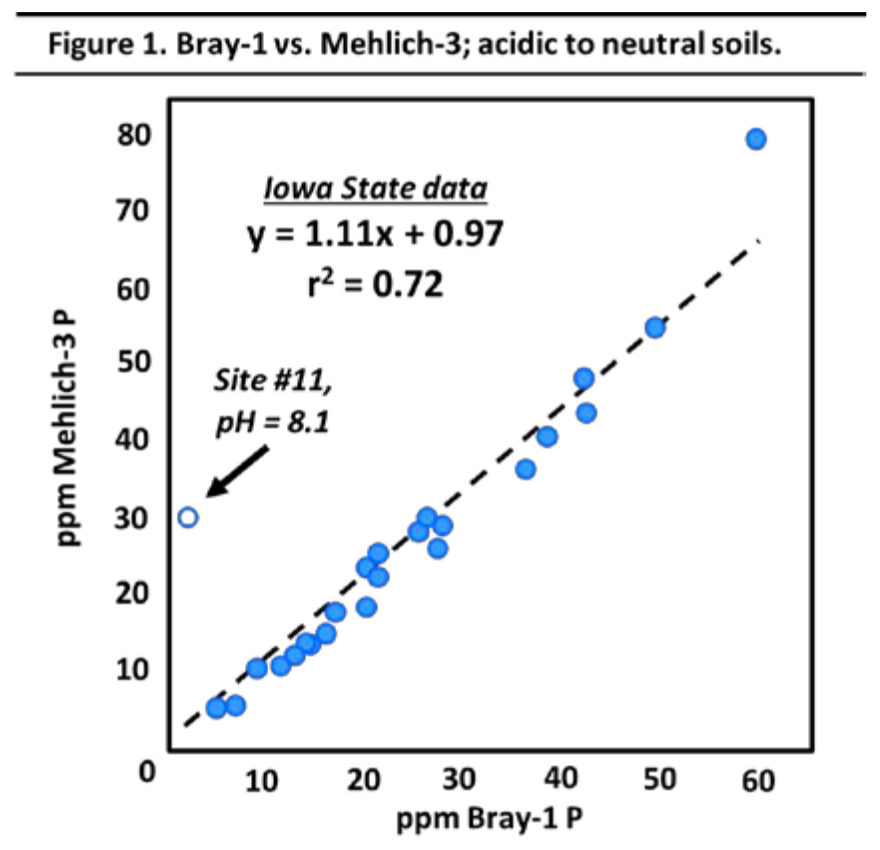
¶ Figure 2. Olsen vs Mehlich-3; Acidic to Neutral Soils
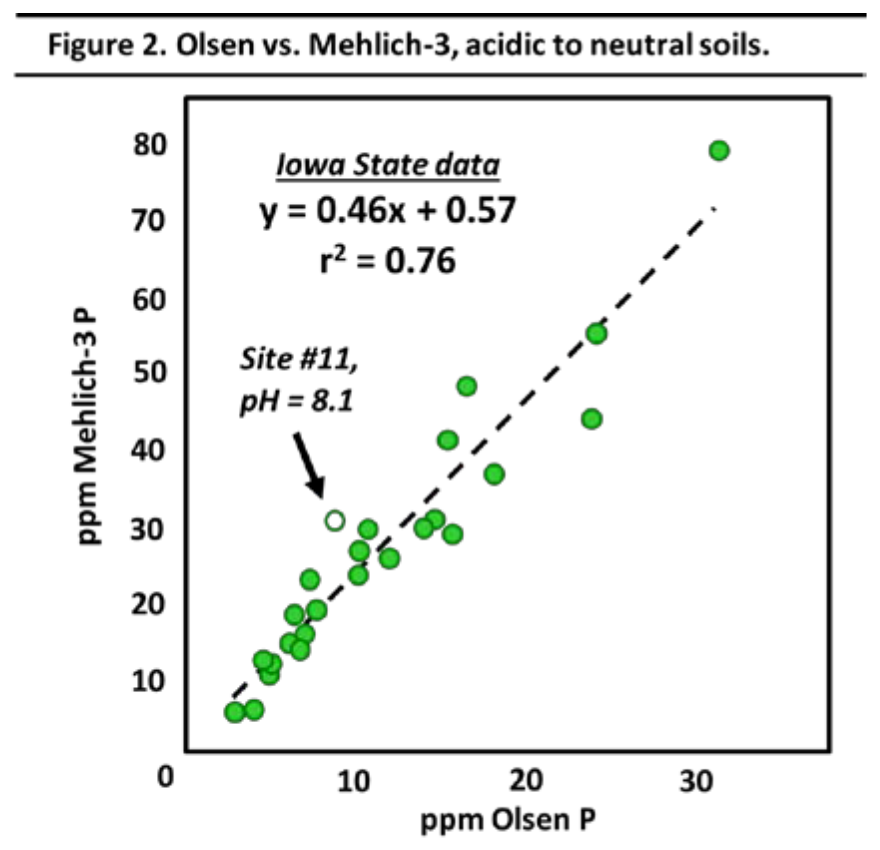
¶ Figure 3. Bray-1 vs Olsen; Acidic to Neutral Soils
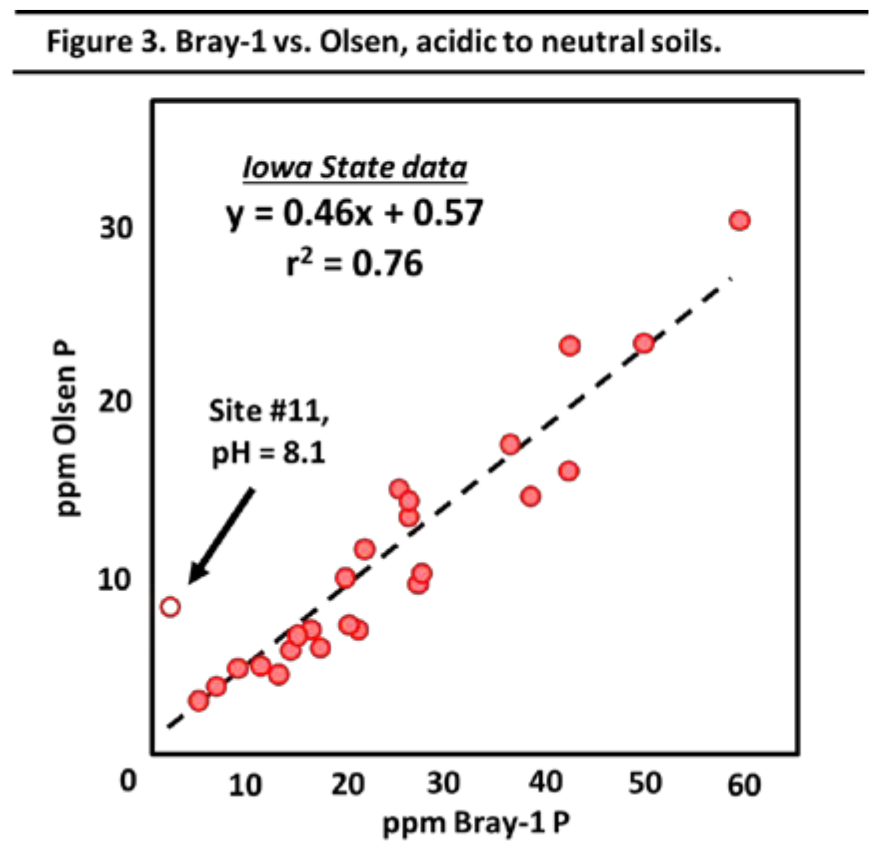
¶ Figure 4. Bray-1 vs Mehlich-3; Alkaline, Calcareous Soils
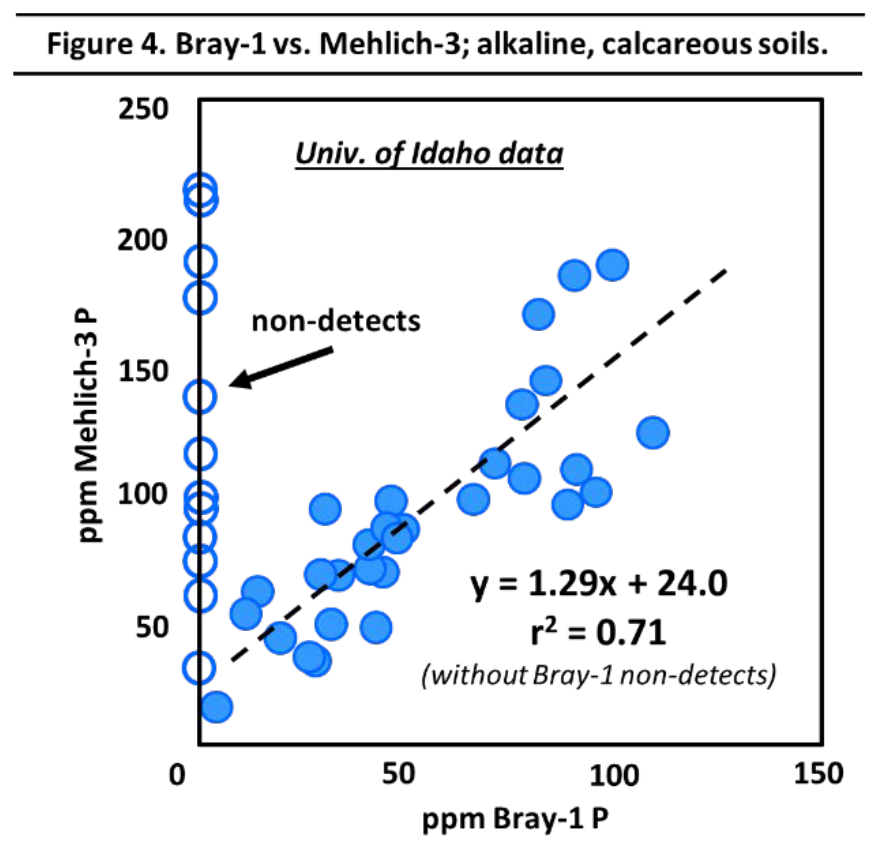
¶ Figure 5. Olsen vs Mehlich-3; Alkaline, Calcareous Soils

¶ Figure 6 Bray-1 vs Olsen; Alkaline, Calcareous Soils
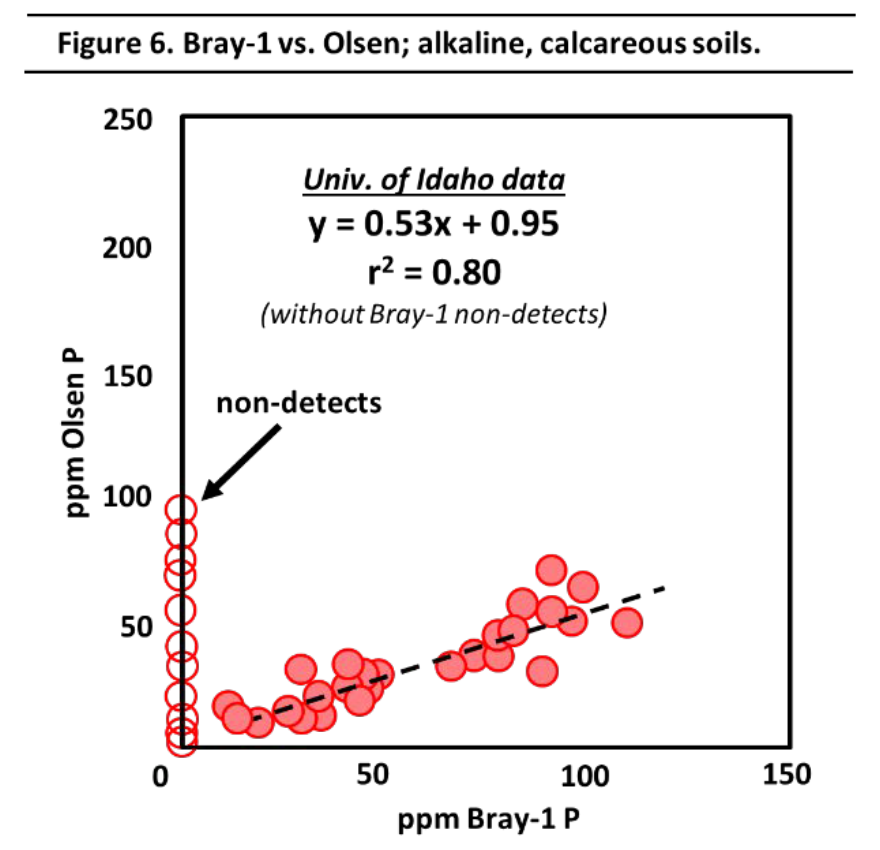
¶ References
Mallarino, A. and A. Blackmer. 1992. Comparison of methods for determining critical concentrations of soil test phosphorus for corn. Agronomy Journal. 84:850-856.
Dari, B., C. Rogers, A. Leytem. and K. Schroeder. 2019. Evaluation of soil test phosphorus extractants in Idaho soils. Soil Science Society of America Journal. 83:817-824.
Bray, R.H., and L.T. Kurtz. 1945. Determination of total, organic, and available phosphorus in soil. Soil Sci. 59:39–46.
Method 340: Extractable Phosphorus - Olsen Method. Univ. of California – Davis, Analytical Lab. https://anlab.ucdavis.edu/analysis/Soils/340 accessed 29Oct2019.